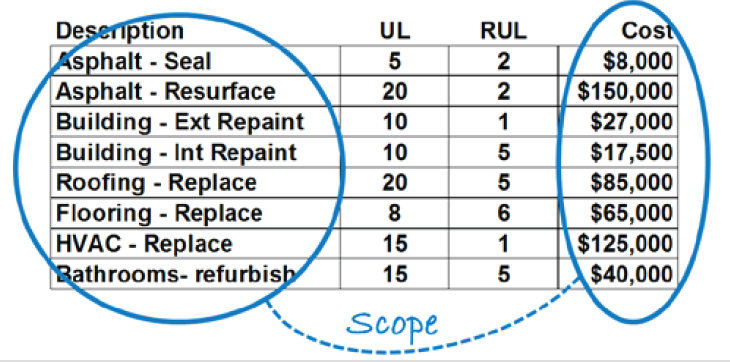We know a few things about the future: 1) that it will come, and 2) it probably won’t be exactly what we expect.
In this spirit, we counsel our house-of-worship clients to be proactive by preparing for the repair and replacement expenses that are both inevitable and predictable. But, we also counsel them to be wise.
When your capital plan shows a component has reached the end of its “useful life,” it should simply be replaced — right? Not necessarily.
A “leaking” roof has clearly failed and requires immediate attention. But, what about those outdated restrooms which are still quite functional? Should we postpone repairs to a cracking parking lot, or should we schedule to resurface it right away?
Let’s begin by reviewing some basic concepts
A church needs to know the condition of its major capital assets to wisely and cost-effectively budget for their eventual replacement. This foundational information is communicated in the Capital Plan’s Component List. The “scope” of a project is communicated by the project’s Description and Replacement Cost ($).
In the example below, it’s easy to see that the scope of work for sealing the asphalt ($8,000) is significantly less than resurfacing ($150,000).

The “schedule” of repairs is communicated by a combination of Useful Life (UL) and Remaining Useful Life (RUL). The UL is an estimate — measured in years — of how long the component was designed to fulfill its intended function. The RUL is an estimate — also measured in years — of how much longer the component will perform its intended function.

As time passes, the RUL of each component naturally decreases. Since outside factors (such as the quality of materials, workmanship, weather conditions and preventative maintenance) can all have mitigating effects on RUL, the rate of the decrease might or might not correspond to the number of passing years.
However, we can clearly define an item with a Remaining Useful Life of “zero” years as having reached the end of its Useful Life.
The Capital Plan also serves as the church’s cash flow management plan, crafted to provide funding that allows for “timely” repairs and replacements. “Timeliness” in a Capital Plan means making a repair or replacement within the year when a component’s RUL reaches “zero” years.
The end of a component’s Useful Life (UL): 3 failure categories
There are three general ways components reach the end of their Useful Life (UL). Understanding these differences will help you make a wise and appropriate decision about executing the project in a “timely” manner, per the Capital Plan schedule, or — wisely — deciding to wait.
#1: Catastrophic failures
This category includes components whose intended function is essential to the health, safety or comfort of people. Boilers, fire alarms and AC systems might — based on observed age and deterioration — have reached the end of their Useful Lives, but could still be serving their intended functions.
However, they could fail “at any time” and cause significant expense, disruption or liability exposure. As such, it is wise to make repairs and replacements in a “timely” manner, as opposed to waiting for a catastrophic failure to occur.
#2: Slow, gradual failures
Asphalt, paint, fencing and roofs fall into this category. The component might be at the end of its Useful Life but still be serving its intended function due to mild weather, low use, enhanced maintenance, or simply good fortune. There might be an opportunity to delay this repair project, on the condition of annual inspections and re-evaluation.
However, in the case of wood painting and asphalt seal coating — where the repairs or replacements protect the underlying construction material — “timely” repairs are essential! Delays in these cases might void a warranty or cause significantly increased future repair or replacement expenses.
#3: Obsolescence
Components facing technological or aesthetic obsolescence have Useful Lives that outlast their “value.” The shag carpet in the fellowship hall, the dated appearance of the elevator interior, and the ancient message board with press-on lettering are good examples. Even though the RUL might have reached zero, waiting for the component to actually fail has little consequence. People can survive a week, months or years until the item is repaired or replaced.
However, while the church can generally postpone these types of repairs after the RUL has reached zero, deferring indefinitely is usually not in the best interests of any organization that wants to remain relevant in the eyes of its members, and wants to be appealing to visitors.
Everyone loves saving money, cutting back, and reducing expenses. However, sometimes there is a tendency to focus on the wrong things, which makes it easy to neglect the larger picture.
Understanding the different ways a component serves the mission of the church — and the implications of its eventual failure — helps church staff make wise decisions. It is crucial for a church to be aware of all the components in its Capital Plan that have reached the end of their Remaining Useful Lives and make wise, informed decisions about when (or when not) to embark on the repair or replacement project.
————————————————————–
Matthew Swain, RS, is Worship Facilities Specialist at San Diego-based Association Reserves. He is a certified Reserve Specialist and has been preparing capital plans for non-profit organizations across the country for more than a decade. Swain currently serves as the national representative for Association Reserves worship facility clients.
This article originally appeared in Church Executive Magazine.

